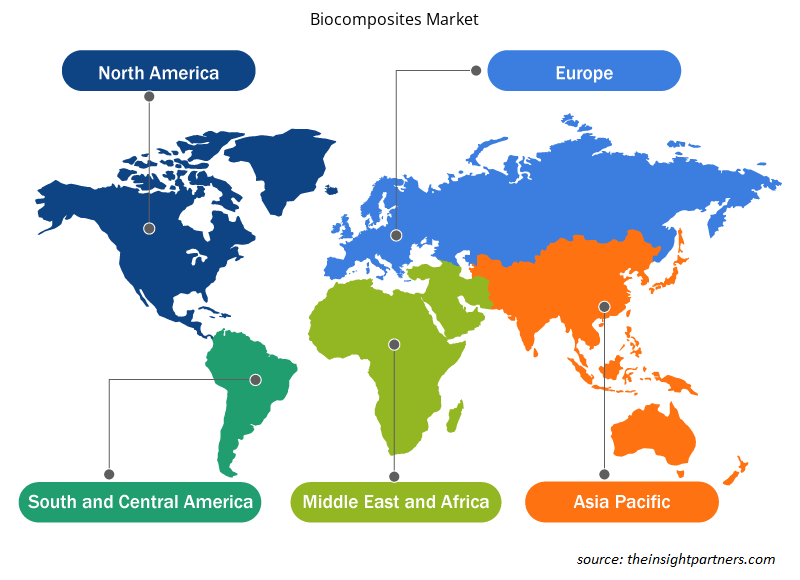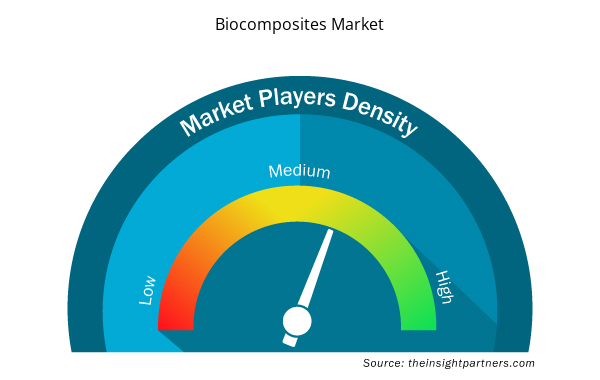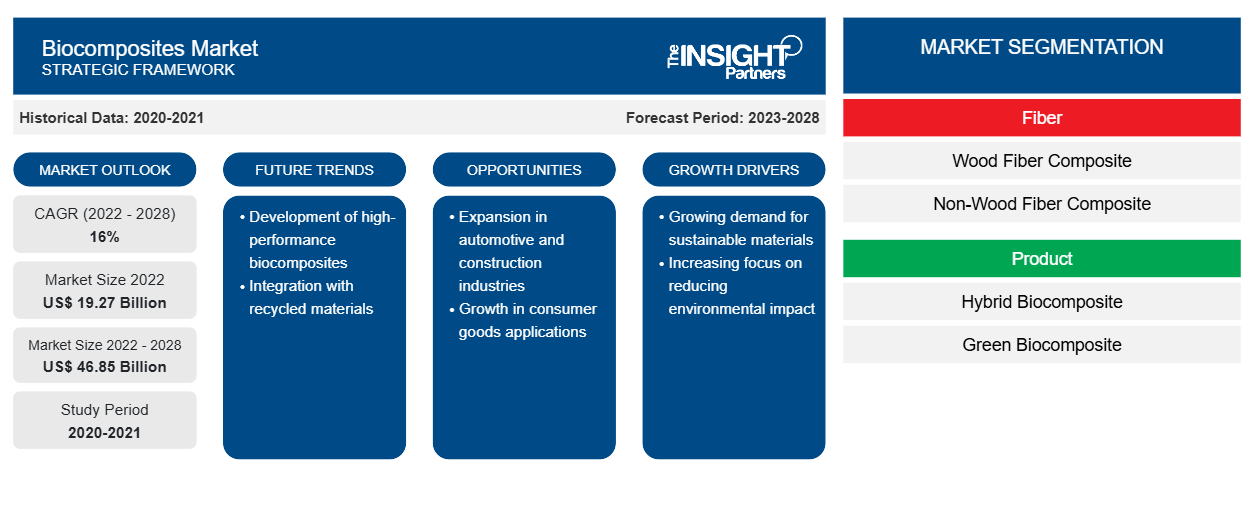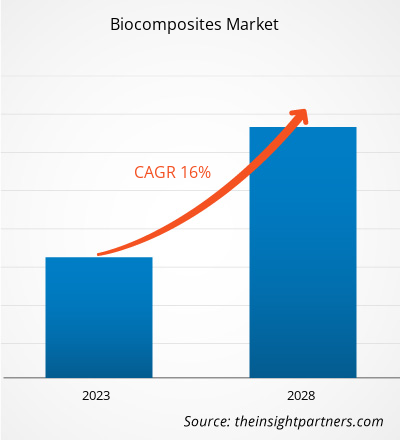[研究报告] 生物复合材料市场预计将从 2022 年的 192.6862 亿美元增长到 2028 年的 468.5139 亿美元;预计2022 年至 2028 年的复合年增长率为 16%。
市场分析
生物复合材料是通过增强天然纤维和基质(树脂)形成的材料。由于生物复合材料具有许多潜在优势,例如易于获得、强度高、重量轻、可生物降解、可回收、成本低廉和可再生,因此终端行业对生物复合材料的兴趣正在迅速增长,例如基础研究、包装、建筑、军事应用、航空航天、铁路客车和汽车。生物复合材料在汽车工业中被广泛用于制造内饰板。由于生物复合材料是环保的,它们正在以高价取代各种应用中的聚合物复合材料。
增长动力与挑战
可持续建筑材料的使用日益增多,促进了生物复合材料市场的增长。由于城市人口不断增长,建筑业是快速城市化过程中最强劲的新兴行业之一。城市化使建筑业成为材料消耗量最大的行业,其中大部分材料来自不可再生资源。根据全球建筑联盟的报告,建筑业是对环境危害最大的行业之一。根据这项研究,建筑业占环境中二氧化碳排放量的 39%,占全球能源消耗的 36%,占原材料开采的 50%。排放是造成气候变化和地球温度升高的主要原因。传统建筑材料资源和能源密集度高。因此,人们越来越关注和意识到传统建筑材料对社会和环境都有危害。为了解决这些问题,建筑业正在开发新材料和新技术。生物复合材料是一种可持续的建筑材料,有助于消除不可再生废物、减少原材料使用和削减化石燃料消耗。全球范围内,建筑行业对生物复合材料的使用兴趣日益浓厚,因为这些材料由可再生、可回收、可生物降解的来源制成,可广泛用作结构和非结构建筑元素。然而,天然纤维复合材料也存在一些缺点,例如纤维基质界面结合力差、润湿性差和吸水性差。这些挑战会影响最终产品的强度和性能。生物复合材料的亲水性往往会从周围环境中吸收水分,从而导致复合材料膨胀。所有这些因素预计都会在预测期内阻碍生物复合材料市场的增长。
定制此报告以满足您的需求
您可以免费定制任何报告,包括本报告的部分内容、国家级分析、Excel 数据包,以及为初创企业和大学提供优惠和折扣
- 获取此报告的关键市场趋势。这个免费样品将包括数据分析,从市场趋势到估计和预测。
报告分类和范围
“2028 年全球生物复合材料市场分析”是一项专业而深入的研究,主要关注全球生物复合材料市场趋势和增长机会。该报告旨在概述全球生物复合材料市场,并按纤维、产品、最终用途和地域对市场进行详细细分。全球生物复合材料市场近年来一直保持高增长,预计在预测期内将继续保持这一趋势。该报告提供了全球生物复合材料消费量的关键统计数据以及主要地区和国家的需求。此外,该报告还对影响主要地区和国家生物复合材料市场表现的各种因素进行了定性评估。该报告还包括对生物复合材料市场主要参与者及其关键战略发展的全面分析。还包括对市场动态的几项分析,以帮助确定关键驱动因素、市场趋势和有利可图的生物复合材料市场机会,进而有助于确定主要收入来源。
此外,生态系统分析和波特五力分析提供了全球生物复合材料市场的360度视角,有助于了解整个供应链和影响市场增长的各种因素。
节段分析
全球生物复合材料市场根据纤维、产品和最终用途进行细分。根据纤维,生物复合材料市场分为木质纤维复合材料和非木质纤维复合材料。根据产品,市场分为混合生物复合材料和绿色生物复合材料。根据最终用途,市场分为建筑和施工、汽车、消费品和其他。
根据纤维,木纤维复合材料占据了生物复合材料市场相当大的份额。木纤维复合材料的主要缺点是其对水分的敏感性,然而,随着研究和开发的不断增加,制造商正在生产具有更高防潮性、更大刚性和更低热膨胀系数的木纤维部件。根据产品,混合复合材料在生物复合材料市场中占据最大市场份额。根据最终用途,建筑和施工部门在生物复合材料市场中占据主导地位。建筑中的生物复合材料用于框架、墙壁和墙板、窗框、门、地板、装饰镶板、隔间墙和天花板。当结构内部设计发生变化时,将生物复合材料用作临时和可调节建筑部件可以减少垃圾填埋。
区域分析
该报告详细概述了全球生物复合材料市场,涉及北美、欧洲、亚太地区 (APAC)、中东和非洲 (MEA) 以及南美和中美洲五大地区。亚太地区占据了相当大的市场份额,2022 年的价值超过 93 亿美元。亚太地区包括中国、印度、日本、韩国和澳大利亚等多个发展中和发达经济体。促进其增长的关键因素是建筑和运输对终端行业的需求不断增加。对生物复合材料的高需求主要出现在中国、日本、印度和韩国。此外,预计交通运输和基础设施领域的外国直接投资 (FDI) 增加将在未来几年推动对生物复合材料的需求。由于政府在基础设施建设方面的支出增加,预计欧洲也将在 2028 年实现约 110 亿美元的可观增长。此外,在北美,生物复合材料在住宅和商业建筑、消费品和汽车领域得到了广泛应用。这为生物复合材料市场创造了丰厚的机会。预测期内,北美生物复合材料市场的复合年增长率将达到 15.0%。
行业发展和未来机遇
合作、收购和新产品发布被发现是全球生物复合材料市场参与者采用的主要策略。
- 2022 年 5 月,阿科玛计划推出其可回收且更高效的复合材料新解决方案。
- 2021 年 3 月,Fiberon 宣布推出野木复合包层,提供木材无与伦比的美感和温暖,以及高性能、低维护材料的耐用性。
生物复合材料市场区域洞察
Insight Partners 的分析师已详细解释了预测期内影响生物复合材料市场的区域趋势和因素。本节还讨论了北美、欧洲、亚太地区、中东和非洲以及南美和中美洲的生物复合材料市场细分和地理位置。

- 获取生物复合材料市场的区域特定数据
生物复合材料市场报告范围
| 报告属性 | 细节 |
|---|---|
| 2022 年市场规模 | 192.7亿美元 |
| 2028 年市场规模 | 468.5亿美元 |
| 全球复合年增长率(2022 - 2028) | 16% |
| 史料 | 2020-2021 |
| 预测期 | 2023-2028 |
| 涵盖的领域 | 按纤维分类
|
| 覆盖地区和国家 | 北美
|
| 市场领导者和主要公司简介 |
|
市场参与者密度:了解其对商业动态的影响
生物复合材料市场正在快速增长,这得益于终端用户需求的不断增长,而这些需求又源于消费者偏好的不断变化、技术进步以及对产品优势的认识不断提高等因素。随着需求的增加,企业正在扩大其产品范围,进行创新以满足消费者的需求,并利用新兴趋势,从而进一步推动市场增长。
市场参与者密度是指在特定市场或行业内运营的企业或公司的分布情况。它表明在给定市场空间中,相对于其规模或总市场价值,有多少竞争对手(市场参与者)存在。
在生物复合材料市场运营的主要公司有:
- 语音合成
- 林格罗夫
- Bcomp 有限公司
- 芬欧汇川
- Flexform 技术
免责声明:上面列出的公司没有按照任何特定顺序排列。

- 获取生物复合材料市场顶级关键参与者概览
新冠肺炎疫情的影响/地缘政治形势的影响/经济衰退的影响
由于 COVID-19 疫情导致的封锁、旅行限制和企业停工对北美、欧洲、亚太地区 (APAC)、南美和中美以及中东和非洲 (MEA) 等多个国家的经济和行业产生了不利影响。这场危机扰乱了全球供应链、制造活动、交付计划以及必需品和非必需品销售。多家公司宣布,2020 年产品交付可能会延迟,其产品未来销量可能会下滑。此外,欧洲、亚太地区和北美各国政府实施的国际旅行禁令迫使多家公司终止合作和伙伴关系计划。所有这些因素都阻碍了 2020 年和 2021 年初的化学品和材料行业,从而抑制了与该行业相关的各个市场(包括生物复合材料市场)的增长。
在 COVID-19 爆发之前,生物复合材料市场主要受到汽车和建筑行业不断增长的需求的推动。然而,在 2020 年,由于国家和国际边界关闭导致价值链中断,各行业不得不放慢运营速度。由于各国政府当局实施的限制,COVID-19 大流行扰乱了关键原材料的供应链并扰乱了制造流程。然而,经济复苏了。先前推迟的建设项目得以恢复,这进一步为生物复合材料市场参与者恢复正常提供了机会。
竞争格局和主要公司
生物复合材料市场的一些主要参与者包括 TTS;Lingrove;Bcomp Ltd;UPM;Flexform Technologies;Tecnaro GmbH;Fiberon;Arkema;Trex Company, Inc.;以及 HempFlax Group BV 等。
- 历史分析(2 年)、基准年、预测(7 年)及复合年增长率
- PEST 和 SWOT 分析
- 市场规模价值/数量 - 全球、区域、国家
- 行业和竞争格局
- Excel 数据集



Report Coverage
Revenue forecast, Company Analysis, Industry landscape, Growth factors, and Trends

Segment Covered
This text is related
to segments covered.

Regional Scope
North America, Europe, Asia Pacific, Middle East & Africa, South & Central America

Country Scope
This text is related
to country scope.
常见问题
The green biocomposite is expected to be the fastest-growing segment during the forecast period. Green biocomposites are typically made by combining a biodegradable polymeric matrix with eco-friendly and renewable fibers. Increasing concern for the environment is driving the growth of green biocomposites during the forecast period.
During the forecast period, the automotive segment is expected to be the fastest-growing segment. Many automotive applications use biocomposites to achieve objectives, including light vehicle weight, fuel economy, low battery weight, low CO2 emissions, and high accident safety. Increasing demand for lightweight and fuel-efficient vehicles is propelling the demand for biocomposites during the forecast period.
The key driver fueling the biocomposites market's expansion is the population's increased awareness of the necessity for eco-friendly materials to protect the environment from degradation. Another aspect driving the biocomposites market's expansion is the growing use of biocomposites to lighten vehicles and increase safety. Other reasons that contributed to the market's growth include the introduction of strict government restrictions and safer usage of biocomposites than glass fiber.
In 2021, Asia-Pacific accounted for the largest share of the global biocomposites market. Due to growing environmental concerns, strict government restrictions, and a sense of social responsibility, the commercial and residential construction sector in the Asia Pacific is booming. Increased use of biocomposites in the building and construction sector led to the dominance of the Asia Pacific region in the global biocomposites market.
In 2021, the wood fiber composite segment held the largest market share. Composites made of wood fiber cost less than non-wood composites. These are used in a variety of applications, including residential, commercial, swimming pool, observation decks, and jetties. These are a few of the factors that led to the dominance of wood fiber composites in 2021.
The major players operating in the biocomposites market are TTS, Lingrove, Bcomp Ltd., UPM, Flexform Technologies, Tecnaro GMBH, Green Bay Decking, Fiberon LLC, Arkema, and Procotex.
Trends and growth analysis reports related to Chemicals and Materials : READ MORE..
The List of Companies - Biocomposites Market
- TTS
- Lingrove
- Bcomp Ltd
- UPM
- Flexform Technologies
- Tecnaro GMBH
- Green Bay Decking
- Fiberon LLC
- Arkema
- Procotex
The Insight Partners performs research in 4 major stages: Data Collection & Secondary Research, Primary Research, Data Analysis and Data Triangulation & Final Review.
- Data Collection and Secondary Research:
As a market research and consulting firm operating from a decade, we have published and advised several client across the globe. First step for any study will start with an assessment of currently available data and insights from existing reports. Further, historical and current market information is collected from Investor Presentations, Annual Reports, SEC Filings, etc., and other information related to company’s performance and market positioning are gathered from Paid Databases (Factiva, Hoovers, and Reuters) and various other publications available in public domain.
Several associations trade associates, technical forums, institutes, societies and organization are accessed to gain technical as well as market related insights through their publications such as research papers, blogs and press releases related to the studies are referred to get cues about the market. Further, white papers, journals, magazines, and other news articles published in last 3 years are scrutinized and analyzed to understand the current market trends.
- Primary Research:
The primarily interview analysis comprise of data obtained from industry participants interview and answers to survey questions gathered by in-house primary team.
For primary research, interviews are conducted with industry experts/CEOs/Marketing Managers/VPs/Subject Matter Experts from both demand and supply side to get a 360-degree view of the market. The primary team conducts several interviews based on the complexity of the markets to understand the various market trends and dynamics which makes research more credible and precise.
A typical research interview fulfils the following functions:
- Provides first-hand information on the market size, market trends, growth trends, competitive landscape, and outlook
- Validates and strengthens in-house secondary research findings
- Develops the analysis team’s expertise and market understanding
Primary research involves email interactions and telephone interviews for each market, category, segment, and sub-segment across geographies. The participants who typically take part in such a process include, but are not limited to:
- Industry participants: VPs, business development managers, market intelligence managers and national sales managers
- Outside experts: Valuation experts, research analysts and key opinion leaders specializing in the electronics and semiconductor industry.
Below is the breakup of our primary respondents by company, designation, and region:

Once we receive the confirmation from primary research sources or primary respondents, we finalize the base year market estimation and forecast the data as per the macroeconomic and microeconomic factors assessed during data collection.
- Data Analysis:
Once data is validated through both secondary as well as primary respondents, we finalize the market estimations by hypothesis formulation and factor analysis at regional and country level.
- Macro-Economic Factor Analysis:
We analyse macroeconomic indicators such the gross domestic product (GDP), increase in the demand for goods and services across industries, technological advancement, regional economic growth, governmental policies, the influence of COVID-19, PEST analysis, and other aspects. This analysis aids in setting benchmarks for various nations/regions and approximating market splits. Additionally, the general trend of the aforementioned components aid in determining the market's development possibilities.
- Country Level Data:
Various factors that are especially aligned to the country are taken into account to determine the market size for a certain area and country, including the presence of vendors, such as headquarters and offices, the country's GDP, demand patterns, and industry growth. To comprehend the market dynamics for the nation, a number of growth variables, inhibitors, application areas, and current market trends are researched. The aforementioned elements aid in determining the country's overall market's growth potential.
- Company Profile:
The “Table of Contents” is formulated by listing and analyzing more than 25 - 30 companies operating in the market ecosystem across geographies. However, we profile only 10 companies as a standard practice in our syndicate reports. These 10 companies comprise leading, emerging, and regional players. Nonetheless, our analysis is not restricted to the 10 listed companies, we also analyze other companies present in the market to develop a holistic view and understand the prevailing trends. The “Company Profiles” section in the report covers key facts, business description, products & services, financial information, SWOT analysis, and key developments. The financial information presented is extracted from the annual reports and official documents of the publicly listed companies. Upon collecting the information for the sections of respective companies, we verify them via various primary sources and then compile the data in respective company profiles. The company level information helps us in deriving the base number as well as in forecasting the market size.
- Developing Base Number:
Aggregation of sales statistics (2020-2022) and macro-economic factor, and other secondary and primary research insights are utilized to arrive at base number and related market shares for 2022. The data gaps are identified in this step and relevant market data is analyzed, collected from paid primary interviews or databases. On finalizing the base year market size, forecasts are developed on the basis of macro-economic, industry and market growth factors and company level analysis.
- Data Triangulation and Final Review:
The market findings and base year market size calculations are validated from supply as well as demand side. Demand side validations are based on macro-economic factor analysis and benchmarks for respective regions and countries. In case of supply side validations, revenues of major companies are estimated (in case not available) based on industry benchmark, approximate number of employees, product portfolio, and primary interviews revenues are gathered. Further revenue from target product/service segment is assessed to avoid overshooting of market statistics. In case of heavy deviations between supply and demand side values, all thes steps are repeated to achieve synchronization.
We follow an iterative model, wherein we share our research findings with Subject Matter Experts (SME’s) and Key Opinion Leaders (KOLs) until consensus view of the market is not formulated – this model negates any drastic deviation in the opinions of experts. Only validated and universally acceptable research findings are quoted in our reports.
We have important check points that we use to validate our research findings – which we call – data triangulation, where we validate the information, we generate from secondary sources with primary interviews and then we re-validate with our internal data bases and Subject matter experts. This comprehensive model enables us to deliver high quality, reliable data in shortest possible time.


 获取此报告的免费样本
获取此报告的免费样本